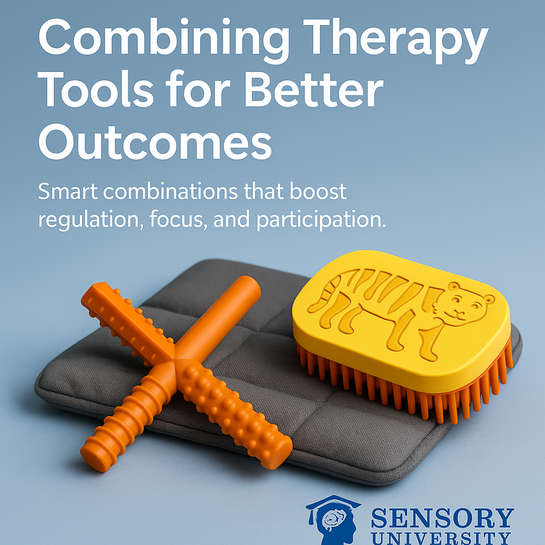In the world of pediatric therapy, no two children experience the world the same way. Each child’s sensory profile, motor skill level, and regulation needs are unique — which is why therapists often achieve the best results by combining multiple sensory tools into a single, focused strategy. At Sensory University®, we believe that progress doesn’t come from one product alone — it comes from the right combination.
1. Pairing Oral Motor Input with Deep Pressure
A child who seeks oral stimulation may also benefit from proprioceptive input that helps calm the body as a whole.
For instance, pairing the Chew Stixx® Original — our FDA-compliant oral motor chew tool designed to safely redirect chewing behaviors — with a Weighted Lap Pad provides both oral and deep-pressure feedback simultaneously.
The Chew Stixx satisfies oral sensory cravings, while the gentle pressure of a weighted product grounds the nervous system, helping the child focus during classroom or therapy activities. This dual-input approach can reduce self-stimulatory behavior and improve attention span.
2. Texture and Touch for Exploration and Focus
For children working on tactile tolerance or fine motor skills, combining texture-based tools amplifies progress. The Tactile Tiger® Brush offers controlled tactile input for desensitization exercises, while a Desk Buddy™ Fidget Bar provides a discreet way to maintain focus during seated tasks.
Used together, these tools build tolerance through graded sensory input and allow the therapist to address multiple sensory systems — touch, proprioception, and focus — within a single session.
3. Building Calm through Multi-Sensory Balance
A sensory program doesn’t always need to be complicated. Sometimes the most effective sessions come from pairing movement with oral or tactile feedback. For example:
-
Use a Wobble Chair for vestibular movement and posture work.
-
Add a Chew Stixx® Junior during seated balance activities for oral regulation.
This combination keeps children centered and regulated while strengthening balance and coordination — a perfect example of how multi-modal sensory input creates a singular therapeutic outcome.
4. Why Combination Therapy Works
Each sensory tool targets a specific sensory channel: oral, tactile, vestibular, or proprioceptive.
When combined, these tools communicate together through the child’s nervous system, allowing for faster integration, improved self-regulation, and measurable carry-over into daily life.
Therapists report that pairing sensory tools can:
-
Improve attention and task completion
-
Reduce anxiety and self-stimulation
-
Enhance participation in group settings
-
Encourage long-term independence in sensory regulation
Find the Perfect Combination
At Sensory University®, our mission is to help therapists and parents create sensory solutions that fit the unique needs of every child. Whether you’re looking to calm, focus, or energize, our range of tools can be mixed and matched for customized, evidence-based outcomes.
Explore professional-grade tools like Chew Stixx®, Weighted Lap Pads, Grip Stixx™, and Tactile Tiger® Brushes — all designed and tested to deliver measurable therapeutic success.

